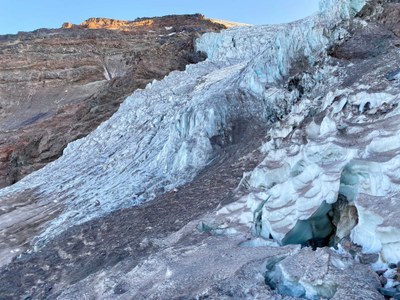
Trip Report
Kautz Glacier / Comet Falls Approach
Late season trip up the Kautz ice chute in an unusual year.
- Sat, Aug 28, 2021 — Sun, Aug 29, 2021
- Intermediate Alpine Climb - Mount Rainier/Kautz Glacier
- Mount Rainier/Kautz Glacier
- Climbing
- Successful
-

- Road suitable for all vehicles
-
As might be expected for late season in a unique year, the route was in navigable but unusual shape. We followed the Van Trump trail up from the Comet Falls TH. Up to Van Trump Park and a bit beyond (roughly 4 miles) is a hike mostly on maintained or good condition climber's trail with initial views of the climbing route available from Van Trump Park.
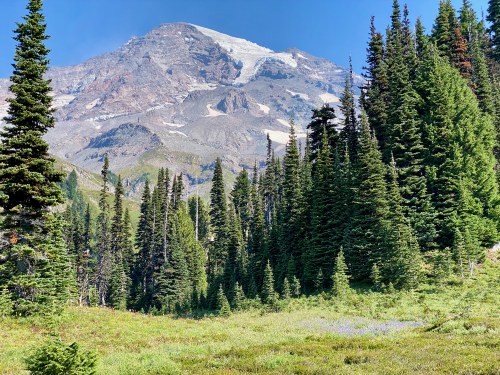
Beyond that, it was loose scree/choss to get to a long snow finger at around 8000' followed by another interval of scree/choss to get to the base of the Turtle at around 9900'.
The Turtle itself was hard, bare ice for the bottom 100', then hard ice below a thin aerated layer for about 600', and then hard granular snow above that. There were multiple large, deep cracks in the Turtle that need to be navigated around.
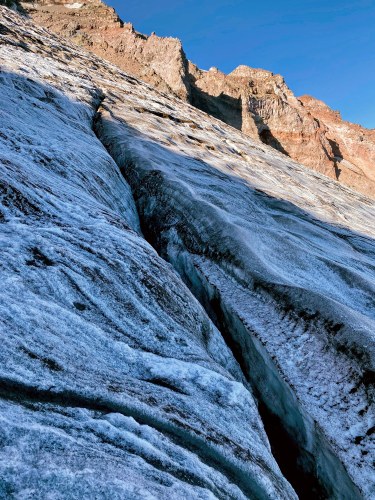
Other than running water on the Kautz itself, there was no water above a small snow patch at the top of the Turtle.
From our camp at 10800, there was a collection of social trails that led up past other campsites to the rock step.
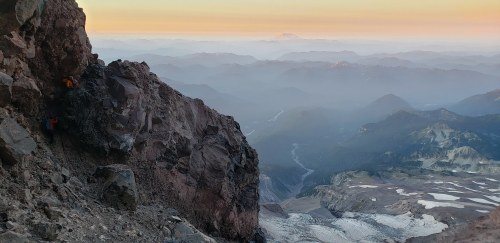
There are multiple lines fixed at the rock step attached to ropes around a massive boulder, all with butterfly knots to isolate core shots or other rope damage.
The climbing route itself was in late season shape with hard clear ice below a ~0.5" aerated layer and climbing composed of a succession of steep ramps, steps, and small bulges.
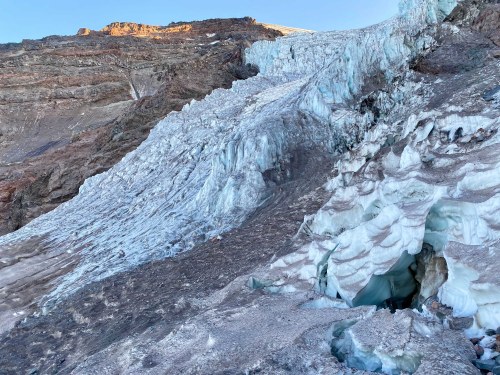
The team met up in Seattle and carpooled to Longmire, picked up our permit at around 7:45AM, and eventually set out from the Comet Falls TH at 8:30AM.
The Comet Falls trail is well-maintained and made for quick travel through forest and past salmonberries, blueberries, and huckleberries. The Van Trump creek crossing was no problem with a little rock hopping.
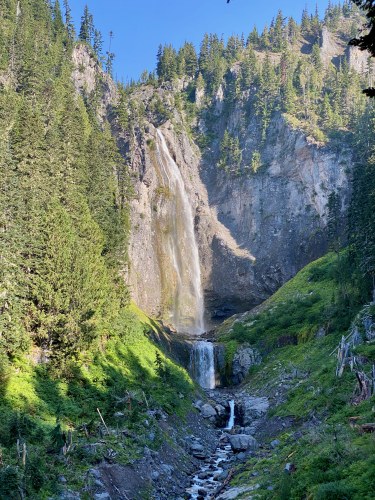
Above the maintained portion, the trail turns into more of climber's trail through Van Trump Park. The meadows were mostly lupine, leftover pasque flower seed-heads, and a few straggling magenta paintbrush.
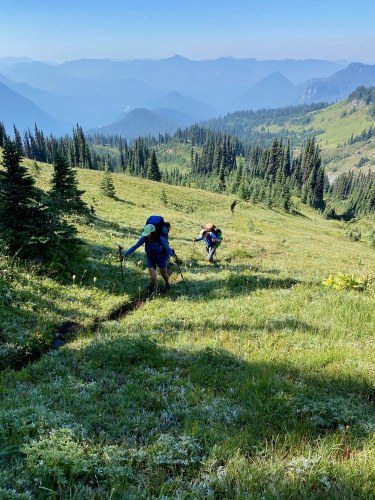
Above Van Trump Park, we cached our trail runners and put on boots, as the route is a succession of pitches of loose screen/choss and snowfields up to the base of the Turtle at 9900. We aimed for as much time on snow as possible, as it was much more pleasant than the choss.
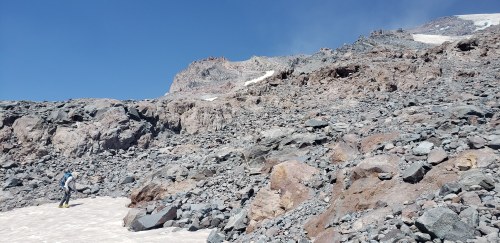
The bottom of the turtle was dirty, hard, exposed water ice, so we put on crampons and got out climbing tools. The group climbed together unroped, working around some large cracks up to the top of the Turtle at around 10,800 with undulations in the ice providing reasonable rests for solo climbing. Around 600' of the Turtle was ice with hard, consolidated corn snow for the last 200'.

At the top of the Turtle, we stopped to filter water at a small snow patch and then contoured over to our camp spot at a group of rock rings. The evening's hazy views included a look at a very cracked and rugged-looking Muir Snowfield.
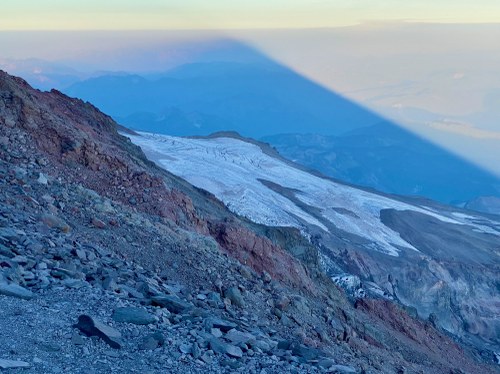
We awoke at a leisurely 4:30AM the next morning and hiked to the rock step with headlamps necessary just until we arrived at the step. The multiple strands of fixed line at the step are tethered to ropes around an enormous boulder, with each strand having multiple butterfly knots to isolate core shots or other damage. We each used two prussiks on our belay loops to squeeze down the step, transferring from one strand to another to work around the knots, and then hustled across to the base of the route, hugging the cliff on our right.
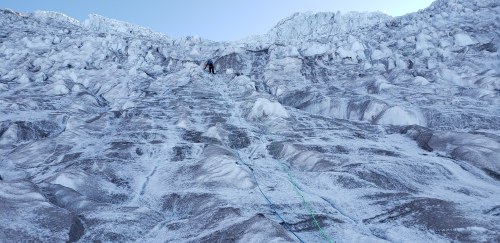
We moved as a group of three on two 60m ropes with the leader clipping alternate strands and followers climbing in parallel. (The goal for this configuration was to minimize our time per pitch and exposure of climbers to dinner plated ice or other debris.) We used 12 screws (2x3 screw anchors, 6 for each pitch) and climbed the bottom step in three pitches with each climber getting a decent-length lead. The upper step looked to be entirely dense knobs and blunt penitentes, which would be fine going up but tedious getting down, so we rappelled the first step in two full-length double-rope rappels on 0-threads and headed for the notch. In spite of the high freezing level (13k), the ice was hard, and head weights would have been convenient.
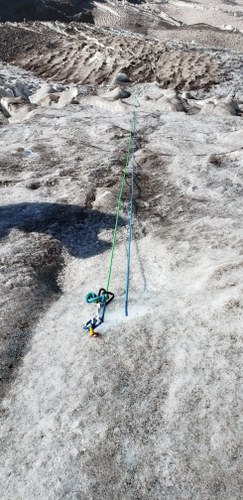
After climbing back through the notch, we broke camp and headed to the top of the Turtle. While we felt comfortable soloing on the way up, a fall would be consequential, so we roped up for the descent. We walked down the first couple hundred feet of hard snow and then started placing screws for a running belay once we reached the point where it was aerated surface over hard ice.
From there, it was a long walk out, retracing our steps to retrieve our cached shoes and eventually reach the car.
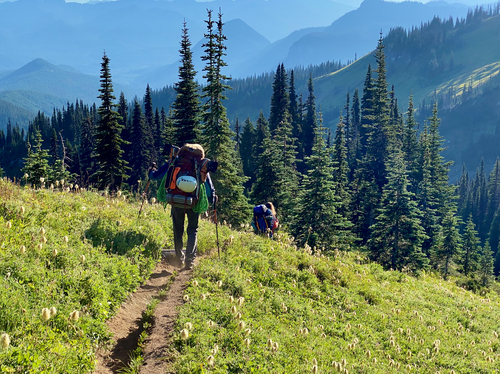
In a less unusual year, the late season might be an enjoyable time to visit the Kautz via this route, although doing it two days was definitely a challenge. Three days — one day to approach to a high camp, one day to climb, one day to hike out potentially — would be more pleasant.
It turned out that a group of Rainier climbing rangers had the same idea and visited the area a few days before we did.
 Paul Brown
Paul Brown